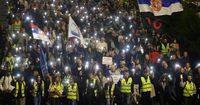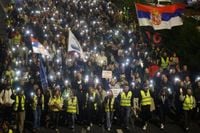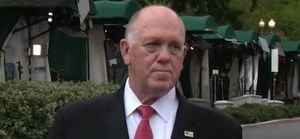On a rainy Wednesday in early October 2025, the streets of Serbia’s largest cities filled with thousands of determined protestors, their faces illuminated by the soft glow of mobile phone lights held high in silent tribute. The demonstration, which spanned several towns including Belgrade and Novi Sad, marked 11 months since a tragic event that has come to symbolize the nation’s growing unrest: the collapse of a concrete canopy at Novi Sad’s newly renovated train station, a disaster that claimed 16 lives—including children—and became the catalyst for a sustained anti-government movement.
According to AP News, the protests reflected persistent resistance to what many describe as the autocratic rule of President Aleksandar Vucic, despite an intensifying government crackdown. The canopy collapse, which occurred in late 2024, was not merely a tragic accident in the eyes of many Serbians. Protesters believe it was the direct result of "graft-fueled negligence" in state construction projects, specifically those tied to a broader railway overhaul involving Chinese companies. The anger and heartbreak from that day have not faded; if anything, they have fueled a movement that now poses the most serious challenge to Vucic’s decade-long grip on power.
In Belgrade, the capital, marchers walked in silence, holding up their phones as makeshift candles to honor the victims. The atmosphere was both somber and resolute. Meanwhile, in Novi Sad, crowds braved heavy rain to gather at the site of the tragedy, undeterred by the weather or the government’s warnings. For once, the demonstrations unfolded without incident—no tear gas, no baton charges—unlike previous rallies where riot police had used force to disperse crowds. This relative calm, however, belied the tension simmering beneath the surface.
University students have emerged as a driving force behind these rallies. Their demands are clear: justice for the victims of the Novi Sad tragedy and early parliamentary elections, which they hope will oust Vucic’s populist government. As reported by Business Standard, one student addressed the crowd in Belgrade, declaring, "There is a way to change things in the country. The first step is for corrupt officials to step away and for the people to realize that our destiny lies in the hands of each of us." The words resonated with many, capturing the spirit of a movement fueled not only by grief but by a deep-seated desire for political transformation.
These protests are not an isolated phenomenon. For months, Serbia has witnessed regular demonstrations challenging Vucic’s leadership. The president, who has ruled for more than a decade, faces mounting accusations of stifling democratic freedoms and allowing crime and corruption to flourish. While Vucic vehemently denies these allegations, the persistence of the protests and the breadth of public participation suggest widespread discontent. According to AP News, the government’s response in recent weeks has been increasingly heavy-handed, with riot police breaking up rallies, detaining and reportedly beating protesters, and scores of demonstrators reporting job losses or financial reprisals as a consequence of their activism.
Milica Stevovic, a Belgrade resident, articulated the frustrations of many when she told AP News, "Serbia has been slowly turning into a dictatorship. Criminal charges have been filed against people who protested peacefully, and not a single person has been charged for the canopy collapse. It is a catastrophe." Her words highlight a core grievance: while the state pursues those who raise their voices, accountability for the tragedy itself remains elusive.
The government’s approach has drawn sharp criticism from both domestic and international observers. Serbia, after all, is still formally seeking membership in the European Union—a process that has been stalled for years, in part due to concerns over the rule of law, democratic backsliding, and the country’s foreign policy orientation. Vucic has maintained close ties with Russia and China, a balancing act that has raised eyebrows in Brussels and complicated Serbia’s EU accession hopes. Meanwhile, his consolidation of power at home has only deepened worries about the country’s democratic trajectory.
For many Serbians, the current crisis is about more than just the Novi Sad collapse or the fate of one political leader. It is about the direction of the nation itself. Protesters see the canopy disaster as emblematic of broader systemic failures: corruption in public works, lack of transparency, and a political system that seems increasingly unresponsive to the needs and voices of ordinary citizens. The fact that the renovation project was part of a wider railway overhaul with Chinese companies has only added to suspicions about the influence of foreign interests and the integrity of public procurement processes.
The student movement, in particular, has injected new energy into the protests. Young people have organized rallies, issued public statements, and called for a nationwide reckoning with both the recent tragedy and the political status quo. Their activism recalls earlier moments in Serbian history when student-led protests played a pivotal role in challenging entrenched power. Yet, as the months drag on and the government’s response grows more severe, many worry about the potential for escalation—and whether genuine change is possible.
Despite the risks, the protestors remain undeterred. The absence of violence during the latest marches was a welcome change, but the underlying issues remain unresolved. As Business Standard noted, the government’s crackdown has included not only physical force but also economic and legal pressures, with many activists reporting that they have lost jobs or faced other forms of retaliation for their participation. This climate of fear, protestors argue, is itself evidence of the very problems they are seeking to address.
At the same time, Serbia’s stalled EU accession process looms large in the background. While the government insists that it is committed to European integration, critics argue that recent events suggest otherwise. The close relationship with Russia and China, coupled with growing authoritarian tendencies at home, has led many to question whether the country’s European aspirations are genuine or merely rhetorical.
As the rain-soaked crowds dispersed late Wednesday night, the sense of urgency remained palpable. The protestors’ message was clear: justice for the victims of Novi Sad, accountability for those in power, and a renewed commitment to democratic principles. Whether these demands will be met—and how the government will respond in the weeks and months to come—remains to be seen. But for now, the movement shows no sign of slowing down, and the memory of 16 lost lives continues to inspire a nation in search of change.
In Serbia’s streets, the struggle for justice and democracy goes on—one silent march, one raised light at a time.






